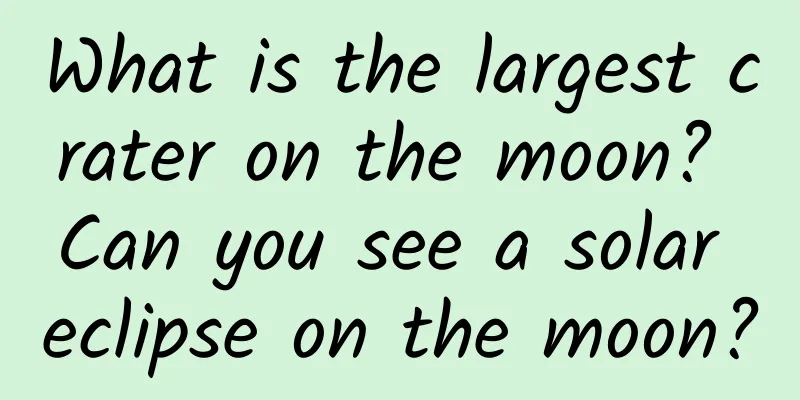What is the largest crater on the moon? Can you see a solar eclipse on the moon?

|
Regarding the solar eclipse that occurs on Earth, can we see it on the moon? I guess many friends are particularly interested in this topic. The surface of the moon is covered with large and small circular pits, called "moon craters". What other secrets are there on the moon? How was the largest crater on the moon formed? The following is a sharing of knowledge in this regard. Contents of this article 1. The largest crater on the moon is 2. Can you see a solar eclipse from the moon? 3. What secrets are there on the moon? 1The largest crater on the moon isThe largest crater on the moon is Clavius, near the south pole of the moon, with a diameter of 230 kilometers. Small craters are only a few dozen centimeters or even smaller in diameter. The moon's surface is covered with large and small circular pits, called "lunar craters", and most of them are surrounded by craters that are higher than the moon's surface. Formation of craters: 1. Shortly after the moon was formed, the hot lava and gas inside the moon broke through the surface and ejected out. The lava ejected and accumulated outside the vent, forming a crater. Later, the ejection power decreased, and the ejection accumulated only at the bottom of the center, forming a small peak, which is the central peak in the crater. Some ejections extinguished early, or there was no ejection again, so there was no central peak. 2. Meteoroid impact on the moon. On May 13, 1972, a large meteoroid impacted the moon, creating a crater as big as a football field. The moonquake caused by the impact was recorded by four seismometers placed on the moon. Those who advocate meteorite impact believe that about 3 billion years ago, there were many meteorites in space and the moon was in a semi-molten state. When the huge meteoroid impacted the moon, it splashed rocks and soil around it, forming a circle of craters. Because there is no wind and rain washing and intense geological tectonic activities on the moon, the craters formed at the time have been preserved to this day. 2Can you see a solar eclipse from the moon?When a total lunar eclipse occurs on Earth, the moon enters the Earth's shadow, and the moon will not be able to reflect sunlight, so a lunar eclipse will occur on Earth. But for observers on the moon, the Earth blocks the sunlight, and this is a total solar eclipse for the moon. Because the Earth is larger than the Moon, the solar eclipse on the Moon will last longer than on Earth. When there is a partial lunar eclipse on Earth, there will be a partial solar eclipse, but there will not be an annular eclipse. When there is a solar eclipse on Earth, there will also be a terrestrial eclipse on the Moon, but it will not be a total terrestrial eclipse, because the Moon is not large enough to block all the sunlight. 3What secrets are on the moon?The detection secrets are as follows: 1. The mystery of the origin of the moon. Scientists have proposed three theories about the origin of the moon. All of them have flaws, but the Apollo program helped prove that the theory that seems least likely is the best theory. Some scientists believe that the moon was formed from a cloud of cosmic dust 4.6 billion years ago, along with the earth. Another theory holds that the moon is the child of the earth, perhaps dug out from the Pacific Ocean. 2. The results of the Polo moon expedition showed that the structural composition of the Earth and the Moon are very different. Some scientists proposed another hypothesis, namely the capture theory. 3. The mystery of the moon's age. Amazingly, 99% of the rock samples brought back from the moon were older than 90% of the oldest rocks on Earth after analysis. The first rock that Armstrong picked up after landing in the Sea of Tranquility was 3.6 billion years old. Other rocks were 4.3 billion years old, 4.6 billion years old, and 4.5 billion years old. It is almost as old as the Earth and the solar system itself. The oldest rock on Earth is 3.7 billion years old. |
<<: What is a lunar rover? What is the temperature inside the moon?
>>: Why is Phase 3 clinical trial of vaccine so important and how long will it take?
Recommend
Caesarean section scar adhesion is actually like this
During the recovery phase, women who have undergo...
Weight change of women in one month
Women's weight basically does not change much...
Can pregnant women take Isatis root granules when they have a cold?
Isatis root granules are a medicine for treating ...
Symptoms of Thalassemia in Pregnant Women
When women are pregnant, they need to protect the...
What should I do if a woman has small fleshy bumps at the urethral opening?
The urethral opening of women is a very private a...
Precautions for pregnant women to take care of themselves during summer confinement
The hot weather in summer may be a difficult thin...
How do dialysis patients cope with depression? 5 practical suggestions for psychological adjustment!
Dialysis, as an important treatment method for pa...
The secret in the refrigerator: Who is secretly creating the crisis?
Modern families cannot live without refrigerators...
What are the symptoms of early pregnancy arrest?
For pregnant women, what they are most worried ab...
What to do with nipple eczema during lactation
Nipple eczema during lactation is a very common s...
Brown discharge on the 8th day of menstruation
If brown discharge is still coming out of the vag...
What color should beginners choose for eyeshadow?
Women are naturally more fond of beauty, and make...
If you have these five symptoms, be sure to be alert to sinusitis!
According to statistics, the incidence of rhiniti...






![[Health Lecture] Hypertension and kidney disease: a hidden "two-way rush" crisis](/upload/images/67eff4140e1ff.webp)


